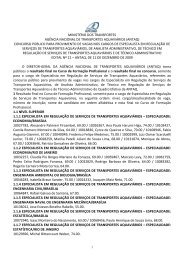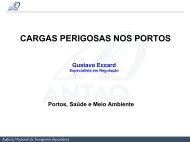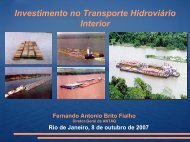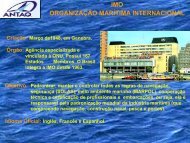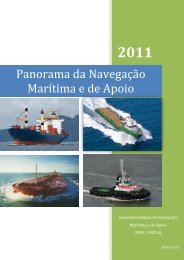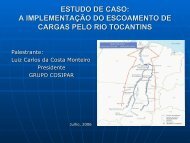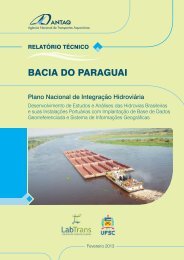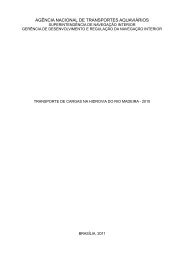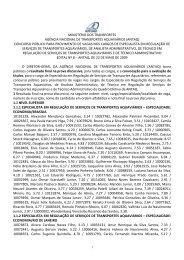Waterway Panorama - Antaq
Waterway Panorama - Antaq
Waterway Panorama - Antaq
Create successful ePaper yourself
Turn your PDF publications into a flip-book with our unique Google optimized e-Paper software.
l <strong>Waterway</strong> <strong>Panorama</strong><br />
Seminar on the Parnaíba <strong>Waterway</strong><br />
In May 6, 2009, in Teresina, ANTAQ and the<br />
State of Piauí promoted the Seminar on the<br />
Parnaíba <strong>Waterway</strong>.<br />
With an approximate length of 1,600km and<br />
located in the Drainage Basin of the Northeast,<br />
the Parnaíba <strong>Waterway</strong> comprises the rivers Parnaíba<br />
and das Balsas and is administered by the<br />
Administration of <strong>Waterway</strong>s of the Northeast –<br />
AHINOR. It is currently used to transport cargoes<br />
of regional interest, but it has potential for the<br />
flow of grains produced in the agricultural frontiers<br />
in southern Piauí, southeastern Maranhão,<br />
and northwestern Bahia.<br />
Completion of the lock system in the area of<br />
the dam of Boa Esperança, the works of which<br />
were interrupted in 1982, with 90% of installations<br />
completed, is considered a priority for the<br />
viability of the waterway, as other works necessary<br />
for correction of natural the bed of the river,<br />
such as dredging, have an easier implementation<br />
and lower cost.<br />
The speakers presented their views on the<br />
waterway, emphasized its importance to logistics<br />
in agribusiness in Brazil, and gave examples of<br />
actions that could contribute to its implementation,<br />
including the Public Private Partnerships –<br />
PPP, appointed by Banco do Nordeste – BND,<br />
highlighting the benefits for the public sector,<br />
such as: reduced need for direct investment,<br />
maximization of public services without bonds<br />
that are typical of the public sector, and payment<br />
after the start of the provision of services.<br />
The Administration of <strong>Waterway</strong>s of the<br />
Northeast, AHINOR, highlights that, with the<br />
coming into operation of Parnaíba, the economic<br />
and social consequences shall be the<br />
raising of the income level of the population of<br />
the regions under the influence of the river and<br />
the possibility of introducing more advanced<br />
agricultural practices; among others; and the<br />
need to restore the river’s course, in the process<br />
general silting due to the lack of protection.<br />
The Government of Piauí defended waterway<br />
transportation as an alternative to the flow<br />
of production. It reported that the average cost<br />
of deployment of the waterway is approximately<br />
US$34,000 per kilometer. In the case of the<br />
highway, this figure rises to US$440,000.<br />
Companhia de Desenvolvimento dos Vales<br />
do São Francisco e do Parnaíba – CODEVASF<br />
presented the São Francisco River Basin Revitalization<br />
Program (PRSF). The program is divided<br />
into five lines of actions:<br />
1. Management and Monitoring;<br />
2. Socio-Environmental Agenda;<br />
3. Protection and sustainable use of natural<br />
resources;<br />
4. Quality of environmental sanitation; and<br />
5. Sustainable Economies.<br />
The ongoing activities consist of basic sanitation<br />
works (solid waste, sewage), flood gullies<br />
and erosion control, improved navigability, and<br />
recovery of riparian areas. According to<br />
CODEVASF, the program should be applied in<br />
the Parnaíba River after adjustments.<br />
ANTAQ presented data from the Study of Estimated<br />
Cargo Demand for the Parnaíba <strong>Waterway</strong>,<br />
which projects a volume of 7.5 million<br />
tonnes of grain produced in the catchment area<br />
of the waterway up to the year 2012 and justifies<br />
the completion of the locks of Boa Esperança,<br />
and investments in dredging and clearing<br />
to make <strong>Waterway</strong> Parnaíba fully navigable.<br />
Estimated Cargo Demand<br />
The Region of Influence considered comprised<br />
the states of Piauí, Maranhão, Tocantins,<br />
and Bahia, which may use the Parnaíba River as<br />
the preferred route for the transportation of local<br />
produce, taking into account the lower efficiency<br />
and absence of other transport means.<br />
In this work, the waterway is considered only<br />
in its navigable stretch between the cities of<br />
Santa Filomena (PI) and Teresina (PI), taking<br />
into account the reservoirs formed by the hydroelectric<br />
plants of Uruçuí, Ribeiro Gonçalves,<br />
Cachoeira, Castelhano, and Estreito, and the<br />
completion of the locks of the HPP Boa Esperança.<br />
The maximum distance in a straight line<br />
between the cities considered and the Parnaiba<br />
River was 375km.<br />
The figure on the next page shows the selected<br />
municipalities and the area of influence<br />
considered in this work.<br />
100



